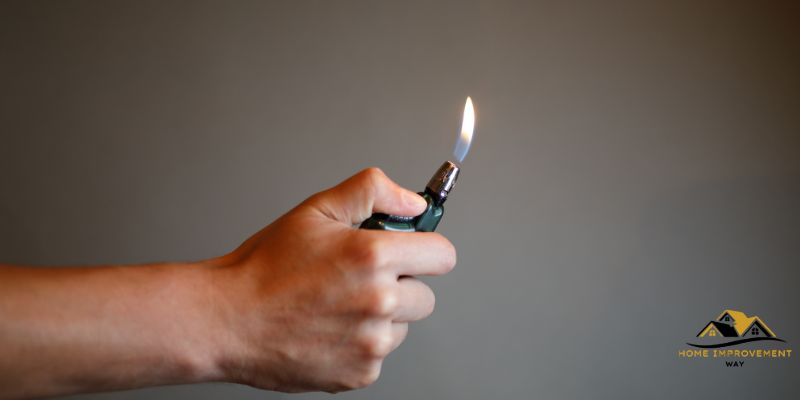To light something without a lighter, you can use alternative methods such as using matches, a magnifying glass, or rubbing two sticks together. These methods rely on creating a spark or heat source to ignite a flame, providing an alternative to using a traditional lighter.
Techniques To Ignite Without A Lighter
When faced with a situation where a lighter is unavailable, knowing alternative methods to ignite can be a valuable skill. Whether you’re camping in the great outdoors or experiencing a power outage at home, here are three techniques for lighting something without a lighter.
Friction-based ignition involves creating heat through the rubbing of two materials. The most popular and widely known method is using a bow drill. With a spinning motion, the bow is used to rotate a wooden drill against a fireboard, causing the friction needed to create an ember. Once the ember is formed, it is carefully transferred to a nest of fine, dry tinder which can be blown on to start a fire. Other friction-based methods include the hand drill and the fire plow.
Spark-based ignition relies on creating a spark to start a fire. One commonly used method is the flint and steel technique. By striking a flint against a hardened steel, sparks are produced. These sparks can then be directed onto a piece of char cloth, which will readily catch fire. Another method involves using a ferrocerium rod, commonly known as a firestarter rod or firesteel. When the rod is quickly scraped with a sharp edge, it releases a shower of sparks that can be directed onto tinder to initiate a fire.
Chemical-based ignition refers to the use of readily available chemicals to produce a fire. Potassium permanganate and glycerin, when combined, create a chemical reaction that generates enough heat to ignite combustible materials. Similarly, a mixture of potassium chlorate and sugar can create an explosive combustion. However, it is important to exercise caution and follow proper safety protocols when using chemical-based ignition methods.
Remember that while these techniques can be useful in emergency situations, it is vital to practice them in a controlled and safe environment before relying on them in real-life scenarios. Always prioritize safety and ensure proper precautions are taken when attempting any of these methods.

Friction-based Ignition
Friction-based ignition offers a practical solution for lighting things without a lighter. By creating friction between two surfaces, such as using a flint and steel or rubbing sticks together, you can generate enough heat to ignite a fire. This technique is useful in outdoor survival situations or when traditional fire-starting tools are unavailable.
The Bow Drill Method
When it comes to friction-based ignition, the bow drill method is a reliable technique for lighting something without a lighter. This ancient method harnesses the power of friction to create enough heat to ignite tinder. It consists of a few key components: a bow, a spindle, a fireboard, and tinder.
In this method, the bow is used to create rotational motion, which in turn generates friction between the spindle and the fireboard. To begin, the spindle is placed onto the fireboard, with the bowstring looped around it. By gripping both ends of the bow and moving it back and forth, the spindle spins rapidly against the fireboard, creating friction and ultimately a small ember.
With consistent and controlled movements, the ember grows larger until it is hot enough to ignite the tinder material, such as dry bark, leaves, or grass. The key to success with the bow drill method is to maintain a steady rhythm and pressure, ensuring that the friction generates enough heat to sustain the ember.
The Hand Drill Method
The hand drill method is another effective technique using friction to light something without a lighter. Unlike the bow drill method, this method relies solely on manual power and requires extra precision and effort.
For the hand drill method, you’ll need a spindle and a fireboard, just like with the bow drill. However, instead of using a bow to create rotational motion, you’ll create it by rotating the spindle between your hands.
To start, place the spindle vertically on the fireboard and apply downward pressure while rapidly rotating it by rubbing your hands together back and forth. This friction between the spindle and fireboard generates heat, resulting in a small ember.
With careful tending and blowing gently on the ember, you can encourage it to grow hotter until it eventually ignites the tinder. Patience and perseverance are essential with the hand drill method, as it requires practice and skill to successfully produce fire by friction.
Spark-based Ignition
When you find yourself in a situation without a lighter at hand, knowing alternative methods to light something can be a game-changer. One reliable method is spark-based ignition, which involves creating a spark to ignite your desired object. This technique can come in handy during camping trips, outdoor adventures, or even in emergency situations. In this article, we will explore two spark-based ignition methods: using a ferrocerium rod and using quartz and steel.
Using A Ferrocerium Rod
One of the most popular methods for spark-based ignition is using a ferrocerium rod. A ferrocerium rod, also known as a fire steel or flint, is a composition of iron, cerium, and other metals that produce sparks when struck against a rough surface. Here’s how you can use a ferrocerium rod to create fire:
- Gather your fire-starting materials: tinder, such as dry leaves or paper, and kindling, such as small twigs or wood shavings.
- Hold the ferrocerium rod firmly in one hand.
- Position the rod close to the tinder bundle and scrape its surface with a sharp edge or a knife in a downward motion, aiming to strike sparks onto the tinder.
- Continue striking the rod, adjusting your technique if necessary, until sparks land on the tinder and ignite it.
- Once the tinder is lit, carefully add the kindling to build up your fire.
- Remember to practice caution and be aware of your surroundings when using a ferrocerium rod.
Using Quartz And Steel
Another spark-based ignition method involves using quartz and steel, which is often referred to as the “flint and steel” method. Unlike a ferrocerium rod, this method relies on the properties of quartz and steel to create sparks. Follow these steps to light something using quartz and steel:
- Prepare your fire-starting materials, including tinder and kindling.
- Hold the steel or carbon steel striker at a slight angle against the quartz rock.
- Apply firm pressure and quickly scrape the striker against the quartz rock, creating small shavings or sparks that fall onto the tinder.
- Continue striking the steel against the quartz rock until the sparks ignite the tinder.
- Once the tinder is lit, carefully add the kindling to build up your fire.
- Keep in mind that the angle and force applied when scraping the striker against the quartz rock can affect the quality and quantity of sparks produced.
Both the ferrocerium rod and the quartz and steel methods offer reliable options for spark-based ignition when a lighter is not available. Practice these techniques in a safe environment to familiarize yourself with the process and ensure you can confidently light a fire when the need arises.

Chemical-based Ignition
Lighting something without a lighter can be achieved by using chemical-based ignition methods. Such methods utilize substances like flammable liquids or flint to create a spark and initiate the ignition process.
Using A Battery And Steel Wool
If you find yourself in a situation where you need to light something but don’t have a lighter on hand, fear not! There are alternative methods available that rely on chemical-based ignition. One such method involves using a battery and steel wool.
To ignite a fire using this method, you’ll need a few items:
- A 9-volt battery
- A small piece of steel wool
Begin by tearing off a small piece of the steel wool, roughly the size of your thumb. Take caution, as the steel wool can be sharp.
Next, gently rub the steel wool against the positive and negative ends of the 9-volt battery. The friction between the steel wool and the battery will cause a chemical reaction, generating heat and sparks.
Hold the steel wool just a few inches away from the tinder material you want to ignite, such as dry leaves or small twigs. The sparks from the steel wool will ignite the tinder, creating a small fire.
It’s important to remember that this method can be dangerous if not handled properly. Always exercise caution and ensure the fire is controlled and contained within a safe area.
Creating A Fire Starter With Chemicals
Another chemical-based ignition method involves creating a fire starter using everyday household chemicals. To put together this simple fire starter, you’ll need the following:
- Potassium permanganate
- Glycerin
First, mix a small amount, approximately a teaspoon, of potassium permanganate with a few drops of glycerin. This combination will create a chemical reaction, releasing heat and igniting a fire.
Once the mixture has been prepared, quickly move away from the area and find a safe place to pour the mixture onto dry tinder material, such as small pieces of paper or wood shavings.
The heat generated from the chemical reaction will ignite the tinder, creating a fire starter that can be used to ignite larger materials.
Remember to exercise extreme caution when working with chemicals, and always carry out these methods in a well-ventilated area.
Conclusion
To wrap up, these simple methods provide effective alternatives for lighting something without a lighter. Whether you choose the battery and gum wrapper hack, lens-focused sunlight, or the trusty friction method using flint and steel, there are options available even when a lighter is nowhere to be found.
Remember to prioritize safety and exercise caution when experimenting with these methods. Happy lighting!


